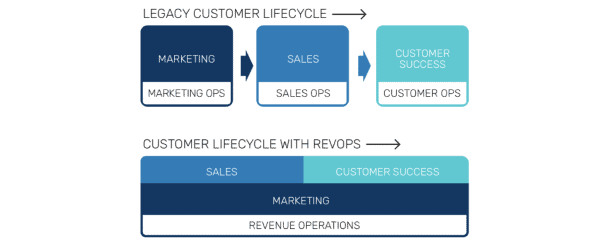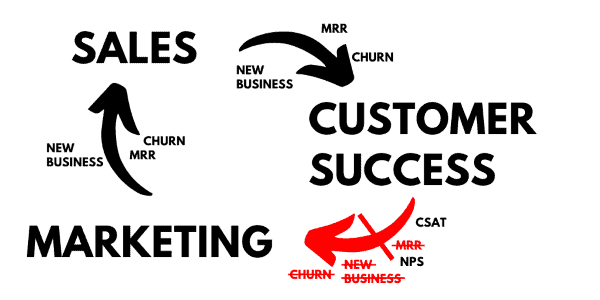Implementing revenue operations (RevOps) in your company can have numerous benefits – increasing revenue coordination across departments, centralizing operations, establishing business-wide accountability, to name a few. It gives you insight into each team’s definition of revenue and revenue generation goals. And by attaining this visibility, SaaS businesses can better focus and align around their revenue goals.
Based on our heavy focus on the topic, it’s no secret that we think RevOps is great.
But no change is victimless. When you introduce a new way of operating, it’s crucial that you ensure existing processes and responsibilities do not fall through the cracks. And, it’s up to you to ensure these existing components are updated accordingly in your new workflow.
Your technology stack is one of these crucial components. It is made up of the tools that your SaaS business relies on. It may have changed from time to time as you grew, but it’s been the foundation for your operations.
So, if you were to introduce RevOps into your SaaS business, how would it affect your technology stack?
In this post, we’ll discuss:
- How RevOps relates to your toolset
- How to figure out if your toolset fits into your new RevOps alignment
Does RevOps change your technology stack?
It might, but it also might not. No two SaaS businesses are the same. So it stands to reason that not every business is affected the same way by RevOps. Some companies may require a massive overhaul in their tooling, while others remain as they were.
While RevOps doesn’t necessarily mean that your technology stack needs to change, what it does mean is that your approach to tooling must change.
The tools previously used by your marketing, sales and CS functions were likely selected because they provided each individual function the necessary capabilities. However, not each team looks for the same functionality in a tool. For example, the variables your customer success team considers for its tools are wholly different than those for your marketing team.
This is fine when teams are functioning independently, but a RevOps approach changes that.
RevOps impacts the relationship between your sales, marketing and customer success teams. These teams no longer operate in siloes. Instead, they now must align under the RevOps umbrella.

(Source)
You want these teams to be able to establish cross-team revenue goals and open channels for sharing information. So, if your current tools can facilitate this, then you likely don’t need to change up your stack. If they can’t, however, you will need to seriously consider switching to tools that support alignment and visibility across marketing, sales and CS.
Need more information on what RevOps does and how it affects teams? Check out our blog post, RevOps – Just Another Buzzword?
How to Tell if Your Tools Align with RevOps
How your technology stack leverages data is a big factor.
Data is the lifeblood of any marketing, sales and customer success team. Without data on customers, these teams would be hard-pressed to do their jobs efficiently. How do you sell something to someone who you have no information on? Or how do you make sure your customer is successful if you are unaware of their goals or history with your company thus far?
Trying to do these things without proper data is like taking a swing in the dark – it’s not effective.
Every toolset offers its own spin on data. Sales teams may favor a certain data set, while marketing does not. It can lead to a lot of mismatches when trying to bring the departments together on a few single metrics to measure success in the customer lifecycle.
This is why you need to assess how each tool in your RevOps stack deals with data. An ideal tool in a RevOps function will either track the same data for marketing, sales and customer support, or it will have tight integrations with tools that other teams use so that metrics are updated and synced across platforms. The main takeaway is that your tools should operate so that all of your RevOps teams are working from the same data set.
There are two ways to assess your tools treatment of data:
- Shared metrics
- Information flow
These two assessments help determine how existing tools fit into your new set up.
Shared Metrics
When you bring your marketing, sales and customer success teams together, you want them to be able to communicate. However, if their tools spit out a smorgasbord of different metrics, it can be hard to find common ground.
That’s why it’s important to have tools that can generate the same metrics. If the customer success team is talking about churn, it’s imperative that marketing and sales have a way – the same way – to measure it too. As we’ve discussed before, shared goals and metrics are imperative to a successful RevOps organization.
At Maxio, we too experienced this problem. As a company that focuses on solving billing and revenue management needs, we, like many of our B2B SaaS customers, are in the process of implementing RevOps practices across our organization to maximize our customer experience and our revenue.
As a part of this, we had to evaluate our own tools and found that our customer success team was using a different CRM software than our sales team. Not using the same tools, in this case, meant that the teams were not accountable for the same metrics, causing us to lose visibility across our customers’ journey.
We knew we needed to consolidate the organization under a single CRM tool. We evaluated the CRM tools that our teams currently used and ultimately selected the one that offered the most functionality for both our sales and CS teams and that offered the most robust and seamless integration with our marketing tools.

Our takeaway? Establish a baseline – make sure your tools can generate data using the same metrics. Having your teams operate on different metrics makes goal-setting and tracking hectic and inefficient.
Information Flow
How do the tools in each department share information? Before aligning around RevOps, your teams likely used siloed tools and, ultimately, worked within their own lanes. Once you decide to embrace a RevOps approach, these teams must break out of their individual containers and work together.
This means openly sharing information.
Yet, if each team uses different tools, the process of trading info across teams can become a belabored – and many times inaccurate – process. No one wants to spend 30 minutes exporting information and plopping it into an Excel sheet just so they can send the data to another team that will likely have to repeat the arduous process of importing the data into their own tool – especially when there are much easier ways to share data via integrations.
And extra time can cost you money, in more ways than one. The point of transfer between marketing and sales is time-sensitive, and it can have a big impact on whether a lead eventually becomes a customer. Put another way — time kills leads.
So, the second thing to assess amongst your technology stack is how easy (or painful) it is to share information between teams. You don’t want to lose leads because of time – or information – lost in your tooling.
Some businesses may find that their current tools can integrate effectively, while others might determine it is worthwhile to shift to more robust tools like Salesforce or Hubspot that offer functionalities across RevOps teams.
Every company is different. It’s up to you to evaluate the tool and decide whether or not it’s fit to serve under a new RevOps set up, where information needs to be shared and updated in real-time.
It’s Important to Evaluate, Even if You Don’t Change
In Maxio’s case, we evaluated our tools and found the ones that were hindering our RevOps alignment. Once found, we had to sit down and reevaluate the tool in the new RevOps environment. Could it be reconfigured to fit into our new set up? If not, was there a sensible alternative?
For us, the answer was yes – in some cases. It was worth us changing and consolidating some of our tooling in order to better enable our teams to operate in a RevOps approach. That being said, some of our tooling stayed exactly the same, and we looked for ways to more tightly integrate our new tech stack.
However, this won’t be the case for all companies. Some SaaS businesses may come to the conclusion that their current tech stack meets their needs perfectly as-is, and they will opt to not make any changes.
The key here, though, is that every company transitioning to RevOps should consider each and every tool their teams use and assess whether or not they support and enable the new, aligned metrics and goals.
Stay tuned on the Maxio blog as we continue to explore what true, revenue-focused alignment means for SaaS companies.

